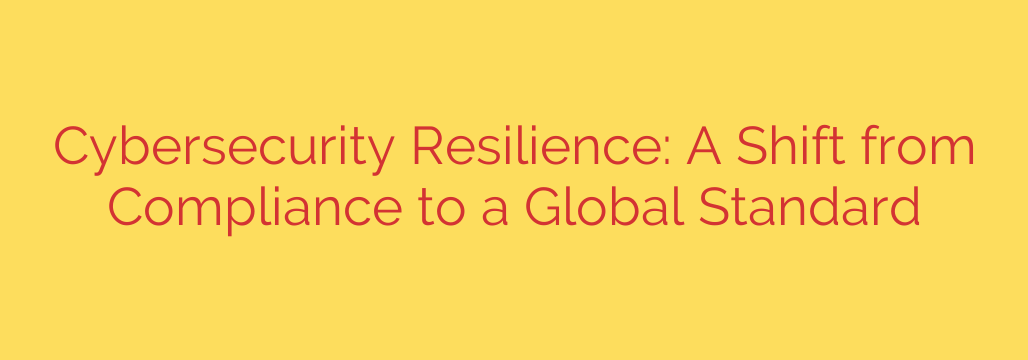
Building a Fortress: Why Cyber Resilience is Surpassing Compliance as the New Security Standard
For years, businesses have approached cybersecurity with a checklist in hand. Meeting compliance standards like GDPR, HIPAA, or PCI DSS was the primary goal—a mark of a job well done. But in today’s increasingly hostile digital landscape, simply checking the boxes is no longer enough. The goalposts have moved from mere compliance to a much more dynamic and robust objective: cyber resilience.
This fundamental shift is not just about terminology; it’s a change in mindset. While compliance focuses on meeting a minimum set of predefined rules, resilience is about an organization’s ability to prepare for, withstand, and rapidly recover from a cyberattack. It accepts the reality that a breach is not a matter of if, but when.
The Cracks in a Compliance-Only Strategy
Compliance frameworks are essential. They provide a vital baseline for security and help protect sensitive data. However, relying on them as your entire cybersecurity strategy is like building a house on a foundation with known weaknesses.
- A Snapshot in Time: Compliance audits are periodic. They verify your security posture at a specific moment, but cyber threats evolve daily. A company can be fully compliant on Monday and vulnerable by Tuesday.
- Reactive, Not Proactive: Most regulations are created in response to past threats. They often lag behind the sophisticated, novel attack vectors used by modern cybercriminals.
- The Floor, Not the Ceiling: Compliance should be seen as the absolute minimum standard for security, not the ultimate goal. It sets the floor for your defenses, but true security requires building well above that baseline.
A compliance-first approach can create a false sense of security, leaving organizations vulnerable to attacks that sophisticated frameworks are not designed to prevent.
The Rise of Cyber Resilience: Preparing for the Inevitable
Cyber resilience is a strategic, proactive approach that assumes your defenses will eventually be breached. It’s less about building an impenetrable wall and more about designing a fortress that can take a hit, contain the damage, and get back to full operational strength quickly.
A truly resilient organization focuses on four key pillars:
- Anticipate and Prepare: This involves proactive threat hunting, vulnerability assessments, and leveraging threat intelligence to understand potential attack vectors before they are exploited. It’s about knowing your enemy and fortifying your defenses accordingly.
- Withstand and Contain: When an attack occurs, the goal is to limit the “blast radius.” Techniques like network segmentation and a Zero Trust architecture ensure that a breach in one area doesn’t compromise the entire system. This pillar is about absorbing the impact without catastrophic failure.
- Recover and Restore: A swift and effective recovery is the hallmark of resilience. This requires a well-documented and frequently tested incident response plan, along with robust, isolated data backups that allow for rapid restoration of critical systems and services.
- Adapt and Evolve: After an incident, a resilient organization doesn’t just clean up the mess—it learns. A thorough post-mortem analysis helps identify security gaps and improve defenses, making the organization stronger and better prepared for future threats.
Actionable Steps to Build Your Organization’s Cyber Resilience
Moving from a compliance mindset to a resilience-focused strategy requires a deliberate effort. Here are practical steps every organization should consider:
- Adopt a Zero Trust Mindset: The core principle of “never trust, always verify” is fundamental to resilience. This means authenticating and authorizing every user and device trying to access resources on your network, regardless of whether they are inside or outside the perimeter.
- Develop and Test Your Incident Response (IR) Plan: An IR plan is useless if it only exists on paper. Conduct regular tabletop exercises and simulated attacks (penetration testing) to ensure your team knows exactly what to do when a real incident occurs.
- Prioritize Immutable Backups and Recovery Drills: Your ability to recover depends entirely on the integrity of your backups. Follow the 3-2-1 rule (three copies of your data, on two different media types, with one copy off-site) and regularly test your ability to restore from them.
- Foster a Security-First Culture: Resilience is everyone’s responsibility. Invest in continuous security awareness training that empowers employees to recognize and report threats like phishing. A vigilant workforce is one of your most effective lines of defense.
- Invest in Continuous Monitoring and Detection: You cannot fight what you cannot see. Implement advanced solutions for endpoint detection and response (EDR) and security information and event management (SIEM) to gain real-time visibility into network activity and identify threats early.
In conclusion, the conversation around cybersecurity is maturing. While compliance remains a non-negotiable part of any security program, it’s merely the starting point. True digital survival and success in the modern era depend on building genuine cyber resilience—the ability not just to prevent attacks, but to endure them and emerge stronger.
Source: https://datacenternews.asia/story/global-cyber-regulation-moves-from-compliance-to-resilience








